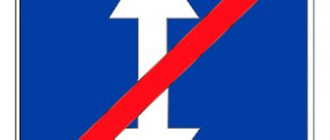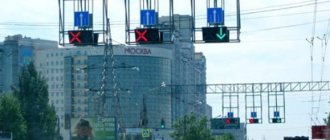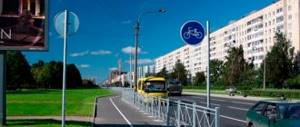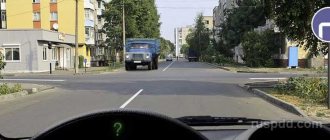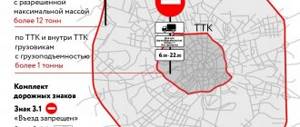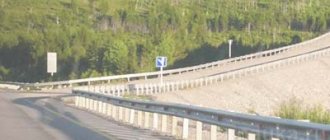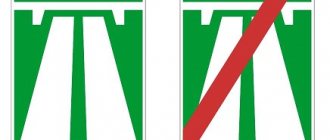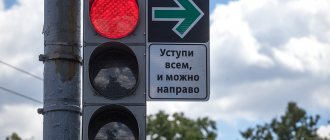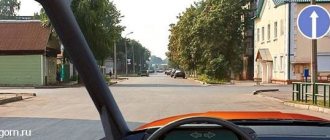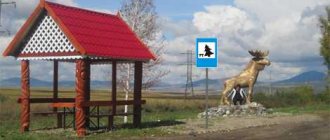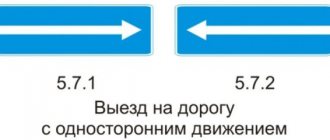The number of vehicles owned by Russians increases by several thousand every year. Therefore, it is not surprising that we spend a decent amount of time in traffic jams every day. Most often, congestion on the roadway occurs in the same place and at certain hours. In this regard, reversible lanes are organized on roads in such areas.
The word reverse itself means return. In road traffic - the ability to move a vehicle in one lane in two directions.
That is, first the flow moves in one direction, and then in the opposite direction. The lane on which the movement takes place remains the same.
Reversible traffic light, what is it?
Every driver has heard about the term “reverse movement”. However, not everyone has encountered it in reality. Reversing movement is often used at a certain period of time when it is required.
The need for these lanes arises on those sections of roads where traffic intensity changes throughout the day. So, for example, in the morning everyone rushes from home to work, and in the evening, vice versa. And in order to avoid hours-long traffic jams, special lanes are being introduced.
Traffic regulation is carried out by means of a traffic light, a traffic police officer or road workers. A reversible traffic light controls traffic in the lane above which it is located.
Sometimes these traffic lights are used in tunnels. Installed above the rows, they make it possible to regulate traffic on the lanes in a short period of time during road accidents or during repair work on the roadway.
Basic rules for moving in reverse flow
Which of the drivers making a turn will violate the rules?
Typically, reversing traffic is installed on straight sections of the road and on highways with a minimum number of intersections. However, in big cities problems often arise, especially if you are approaching from an adjacent street or area.
In this case, you must adhere to the following rules:
- You cannot cross the entire roadway if you need to go, for example, to the left.
- It is necessary to join the general flow and drive to the nearest intersection, at the same time changing lanes into the far left lane in order to make a U-turn at the intersection, if it is not prohibited by the rules.
- According to traffic regulations, you can enter the reverse road from any direction, and exit in the far right lane.
- Advancement is allowed only in cases where the road situation allows it.
- It is prohibited to cross marking 1.9, separating traffic flows in different directions, on the left side; this will be classified as entering oncoming traffic.
The Code of Administrative Offenses does not have special articles devoted to sections with reverse traffic, so violations will be fined based on the situation.
The most common situation is ignoring traffic lights. So, if a red cross is on, then entering the lane is equivalent to entering oncoming traffic. For this, according to Article 12.15 Part 4, a fine of 5 thousand rubles is imposed. If you commit this violation again and this fact is recorded by a traffic police inspector, you can lose your license for a year.
If there is an obstacle in front of you on the road and you go around it on the left, entering the oncoming lane, that is, crossing marking 1.9, then such a violation is considered under Article 12.15 of the Administrative Code, Part 3 - a fine of 1-1.5 thousand rubles.
The violator may also be punished for incorrectly positioning the vehicle when crossing intersections in different directions. There are certain features here. So, even if you need to turn left from the reverse lane onto a road with normal traffic, then according to the traffic rules, this can be done in such a way that your car on an ordinary road with two-way traffic takes the extreme right position.
This moment is very often recorded, because video recording cameras are posted at such intersections. In case of violation, the fine is levied under Article 12.15 Part 1 - 1,500 rubles.
To avoid all these fines, you need to follow traffic lights, markings and road signs. True, it can be encouraging that if a violation is recorded on camera, the license is not confiscated, but a fine is issued.
Despite the fact that in Europe and America this method of regulating traffic has proven itself to be the best and has been actively used since the late nineties, in Russia they reacted ambiguously to this. When the reverse movement was first used in our country, its opponents appeared. Indeed, as practice has shown, this had no effect on reducing the number of accidents; on the contrary, when organizing it, some drivers began to get confused and make mistakes.
Thus, scientists from European countries conducted experiments, which as a result showed that adjusting the reversibility has no effect on reducing accidents. Of course, the positive aspects include the fact that this makes it possible to achieve an increase in the average speed of about 10 km/h, and in some cases more. This method allows you to increase capacity, both on temporary sections of roads during their repairs, and during peak hours.
This movement is rarely used in Russia and only in large cities. Examples include a small number of streets in Moscow, Samara, and the city of Yekaterinburg, where Sheinkman Street temporarily becomes one-way during morning rush hours.
Signs of a reversible lane
Any driver does not want to become the culprit of a traffic accident. Therefore, every car owner is obliged to remember the traffic rules and repeat them from time to time, since changes are made to the rules every year.
So, the main signs of reverse movement that the driver must pay attention to:
- Working reversible traffic light.
- Sign indicating the beginning of a reversible lane.
- Marking in the form of a double broken line on both sides of the strip.
Reversing traffic according to traffic rules
It’s enough to just figure out what reverse movement means. It involves driving in the same lane in different directions depending on the time of day.
There are a number of different issues that you will need to familiarize yourself with in advance - before you start driving on the road of the type in question.
Such questions include the following:
means of adjustment:
- Signs.
- Marking.
- Traffic light.
- how the organization system works;
- penalty when entering the lane.
Adjustments
It is important to know that there are certain standards for driving on this type of road. There are special means related directly to the direction of movement, regulating it during the time of day
These primarily include road signs, markings and traffic lights.
There are special means related directly to the direction of movement and its regulation during the time of day. These primarily include road signs, markings and traffic lights.
Signs
At the moment, there are as many as 3 different signs that are directly related to the regulation of traffic in lanes where reverse occurs:
| Sign No. 5.8 | Indicates road sign sign with reversible traffic |
| Sign No. 5.9 | Looks like a crossed out vertical double-sided white arrow, indicating the end of a road with reverse traffic |
| Sign No. 5.10 | A vertical double-sided arrow crossed out diagonally by a red line indicates the end of a road with reverse traffic. |
It is important to carefully monitor the presence of such signs on the road. Otherwise, you can simply confuse the direction of movement
The result is a fine or an accident.
Photo: sign 5.8
Photo: sign 5.9
Photo: sign 5.10
Marking
It consists of two broken lines parallel to each other. Typically, lanes for reversing traffic are marked not only by markings, but also by a special sign.
Photo: markup 1.9
This marking is used to separate traffic flows when traffic lights are turned off, which usually implement this function.
Traffic light
A reversible traffic light works in the same way as a regular traffic light. The color signals are completely identical.
Photo: reversible traffic lights
But it should be remembered that the effect of a reversible traffic light only applies to the lane with the corresponding traffic. When starting to move or change lanes, this point must be taken into account.
How the organization system works (travel rules)
Reversible lanes are usually used only during certain hours. In each city, the traffic pattern and time intervals may differ slightly.
The strip is highlighted by a double broken line, which is three times shorter than the main part. First of all, you need to focus on working traffic lights.
If a traffic light for reversing traffic is installed above a traffic lane and it is turned off, then the use of this lane for driving a car is prohibited.
A green traffic light means traffic is allowed, a red light means traffic is prohibited. At the same time, a yellow traffic light indicates a requirement to move into the adjacent lane.
Video: reverse movement
Penalty for leaving the lane
Serious fines have been established for violating the traffic rules on roads with reverse traffic. In this case, the amount of the fine is determined precisely by the type of violation itself.
For example, if for some reason the driver does not change lanes after leaving the lane with reverse traffic, then the fine will be 500 rubles.
The fine in this case is 5 thousand rubles. The reason for such a large amount is that on the other side the traffic light can be turned on and cars will move.
There are many different nuances associated with the use of reverse movement.
Signs
Reversing movement is indicated by a white arrow with two tips up and down on a blue background. Accordingly, the same sign, but crossed out with a red line, indicates the end of the reverse lane.
When approaching this lane, a sign indicating the number of meters to it informs you. For example, the reverse row is located five hundred meters away. Consequently, a sign with a white double-sided arrow and below a plate with the number 500 m on a white background are installed half a kilometer from the beginning of the strip.
It is worth noting that the coverage area of the “reverse traffic” sign may include intersections. The end of the road with this type of movement is indicated only by the sign “End of reverse movement”.
Marking
Every driver should be able to distinguish between reverse and normal lane traffic. If only because the latter allows you to move only in one direction. And the reverse movement changes over time. Its stripes are located in the center of the roadway. The marking looks like a double broken line. Moreover, the length of the solid (white) part is equal to three lengths of the spaces between them.
Options for applying road markings:
- One line in the center of the road. This marking indicates that the roadway has two lanes with reverse traffic. They are located on both sides of the line, that is, on the right and left sides of it.
- Several lines. With this method of marking, the reversible traffic lane is the one that is limited on both sides by double broken lines.
It is unclear why there are no road signs that would indicate reversible lanes. After all, they are located next to ordinary ones. There is a sign indicating a road that has a reversible lane. But which one exactly is not indicated. Reversing traffic lights are also not helpful in finding a lane. After all, it only regulates movement along it, but does not designate it in any way. To determine where this strip is, there are markings. And this is where the rub comes in. In dry summer weather there will be no problems with determining the location of the strip. But what to do if there is snow or mud that has blocked the lines? After all, if there are no markings, then there are no reversible lanes. No one has yet given an exact answer to this question.
Reverse traffic sign - basic concepts
On roads with reversible lanes, vehicles and trucks can pass in opposite directions. Naturally, not at the same time: reversible lanes on one day of the week can be designed for driving in one direction, and on another day - in the completely opposite direction. For example, on weekdays there are more lanes for traffic into the city, and on weekends - from the city. Switching is possible depending on the time of day (that is, during rush hours), the presence of holidays and weekends, etc.
This leads to a characteristic feature of the reverse movement of vehicles - it is organized on parts of the road, usually on one (maximum two) lanes. There are no completely reversible highways. When roads outside cities are narrowed, traffic reversal poses a serious danger and therefore does not occur. Multidirectional organization of traffic flows requires a central location of reverse lanes, their sufficient number and clear designation - not only through signs.
The meaning of reverse traffic light signals
As already mentioned, traffic on the lane is regulated by a reversible traffic light. The rules of travel, according to its signals, are similar to the usual ones. The main difference is the appearance. If in a regular traffic light the signal looks like a circle of red, yellow or green, then in a reverse traffic light it is signs.
Symbols:
- A traffic light signal in the form of a red letter X prohibits movement in the reversible lane above which it is installed, since at this time oncoming traffic begins to travel along it.
- A sign depicting an inclined arrow. Its tip is directed to the right or left side. It reports an imminent change from a prohibiting signal to an enabling signal or vice versa. Moreover, the driver is obliged to change lanes to the one the arrow points to. The yellow signal of a regular round traffic light prohibits movement, but the reverse one does not. You have every right to start driving and not change lanes until the light turns red.
- A traffic light signal in the form of a green arrow allows you to move a vehicle along the lane above which it is installed.
Do not forget that a traffic light regulates traffic only on the reversible lane above which it is located.
What is reverse movement?
At different times of the day, traffic flows are unevenly distributed. For example, in the morning, when people go to work, the movement is mainly from the outskirts to the center, and in the evening, vice versa. To balance the movement, special rows were invented, driving along which is possible in both directions.
For regulation use:
- road markings;
- special characters in the form of signs;
- reversible traffic lights.
At the right time, a green signal turns on for one of the directions and a red signal lights up for the opposite. The measure is designed to reduce traffic jams on narrow sections of the road or in conditions of increased traffic flow. So, considering the concept of a reversible traffic light and what it is, it is noted that this is a road symbol designed to regulate travel in specialized areas.
Driving on the reverse lane
Driving on a road with reversible traffic must be carried out with special care. It requires unquestioning compliance with the rules. The slightest mistake or slowdown, and now there is an oncoming lane in front of you, although only a couple of seconds ago everyone was moving in the same direction as you.
It is allowed to change lanes within the visibility range of a control device on a reversible road when the permit signal is given. If you are moving and a prohibitory signal appears, your actions should be concentrated on leaving the lane as quickly as possible. You also have the opportunity to leave it at any time when given the permission signal.
You can move along the reversible lane until there is a sign indicating its completion. After driving, it is regulated by the usual traffic rules.
The rules for driving on reversible roads can be summarized in several points:
- Entry is permitted when the green or yellow traffic light above the reverse lane is on.
- When the traffic light is off or when the light is red, it is prohibited to move your vehicle into the reverse lane.
- Traffic regulations require an immediate exit from the reverse lane if the traffic light above it turns red or stops working.
Pros and cons of reverse movement
| pros | Minuses |
| Improving traffic coordination on roads with insufficient number of lanes | Does not help relieve congestion on roads that are congested in both directions at peak times |
| Rational flow loading, variable use of the road in forward and reverse directions is possible | |
| Use of signs, markings and traffic lights (previously, when clearing traffic jams, the intervention of traffic police inspectors was required, which entailed additional costs) | |
| Absence of the negativity of commuting migration (daily trips of the population from one locality to another, to work, study and back) | |
| Saving time spent on the road by the driver is 20–40% |
In practice, despite the fact that “through passage” solves the problem of traffic congestion, it is not universal. The development of this direction requires certain costs, which consists of equipping road sections with traffic lights, signs and markings.
Many drivers generally do not know the rules regarding reverse traffic and create an emergency situation on the roads. Therefore, in our country this traffic regulation is rarely used, and only in cities with a population of 1 million or more people.
In most cases, roads with reversible traffic can be seen in Europe; they exist in France, Germany, the USA, Australia, and Canada. With the mentality of Russian drivers who try to drive through red traffic lights by opening reversible lanes, the accident rate on the roads increases.
Nuances of reverse movement
An interesting fact about a yellow reverse traffic light: the tip of the arrow can point to any adjacent side. Changing over to the right lane is, in principle, quite simple. But going to the left is an interesting maneuver. After all, the direction of the arrow does not oblige you to change lanes strictly to the indicated side, but only informs. Based on this, when asked to turn left, you can move into the right lane, which is also permitted, without violating traffic rules.
Drivers are often punished for making the wrong exit from a reverse road onto a regular one. In order not to shell out your hard-earned money for a fine, you need to remember one of the points of the traffic rules. Your vehicle should be positioned in the far right lane, at an intersection where the reversible lane ends on the right. Even if you plan to turn left later.
The intersection of roads with reverse traffic is carried out taking into account the same rules as the passage of regular intersections. You should always remember this, and moving around will not be difficult.
Stopping on a road with reverse traffic is strictly prohibited.
It is allowed to cross the markings only if its location is on the right side relative to you.
Fines for violating the rules for driving in the reverse lane
- You can enter the reverse lane from any intersection, and leave only from the right lane.
- Once you reach the “through passage”, change lanes to the right.
- Getting ahead is possible only if the maneuver does not interfere with others.
- Driving beyond the marking lines on the left is prohibited.
- It is prohibited to stop in such areas; if necessary, go to the right.
- If the yellow signal comes on or a red one is approaching, immediately change lanes in the same direction.
Fines
Any failure to comply with traffic rules entails punishment. What kind of punishment you face for not complying, of course, depends on what you violated.
For example, if you turn incorrectly into the reverse lane, you will receive a fine of five hundred rubles or more. And for leaving when the traffic light is turned off or there is no traffic light, the penalty is twice as heavy. It makes no sense to list all preventive measures, since changes are often made to traffic rules. The main thing is to remember that your failure to follow traffic rules may subsequently deprive another person of their life.
